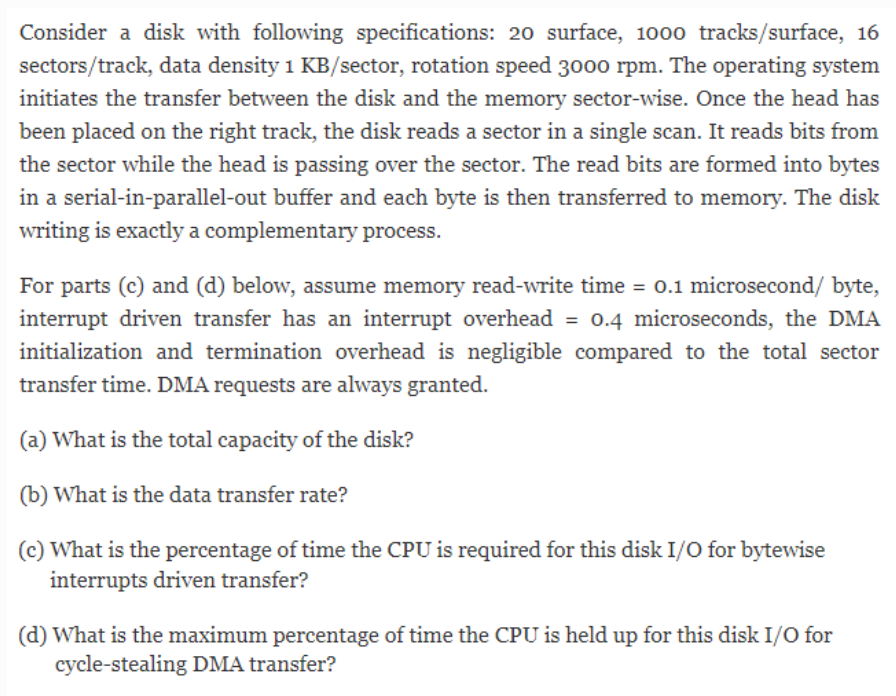Consider a disk with following specifications: 20 surface, 1000 tracks/surface, 16 sectors/track, data density 1 KB/sector, rotation speed 3000 rpm. The operating system initiates the transfer between the disk and the memory sector-wise. Once the head has been placed on the right track, the disk reads a sector in a single scan. It reads bits from the sector while the head is passing over the sector. The read bits are formed into bytes in a serial-in-parallel-out buffer and each byte is then transferred to memory. The disk writing is exactly a complementary process. For parts (c) and (d) below, assume memory read-write time = 0.1 microsecond/ byte, interrupt driven transfer has an interrupt overhead = 0.4 microseconds, the DMA initialization and termination overhead is negligible compared to the total sector transfer time. DMA requests are always granted. (a) What is the total capacity of the disk? (b) What is the data transfer rate? (c) What is the percentage of time the CPU is required for this disk I/O for bytewise interrupts driven transfer? (d) What is the maximum percentage of time the CPU is held up for this disk I/O for cycle-stealing DMA transfer?
Consider a disk with following specifications: 20 surface, 1000 tracks/surface, 16 sectors/track, data density 1 KB/sector, rotation speed 3000 rpm. The operating system initiates the transfer between the disk and the memory sector-wise. Once the head has been placed on the right track, the disk reads a sector in a single scan. It reads bits from the sector while the head is passing over the sector. The read bits are formed into bytes in a serial-in-parallel-out buffer and each byte is then transferred to memory. The disk writing is exactly a complementary process. For parts (c) and (d) below, assume memory read-write time = 0.1 microsecond/ byte, interrupt driven transfer has an interrupt overhead = 0.4 microseconds, the DMA initialization and termination overhead is negligible compared to the total sector transfer time. DMA requests are always granted. (a) What is the total capacity of the disk? (b) What is the data transfer rate? (c) What is the percentage of time the CPU is required for this disk I/O for bytewise interrupts driven transfer? (d) What is the maximum percentage of time the CPU is held up for this disk I/O for cycle-stealing DMA transfer?
Computer Networking: A Top-Down Approach (7th Edition)
7th Edition
ISBN:9780133594140
Author:James Kurose, Keith Ross
Publisher:James Kurose, Keith Ross
Chapter1: Computer Networks And The Internet
Section: Chapter Questions
Problem R1RQ: What is the difference between a host and an end system? List several different types of end...
Related questions
Question

Transcribed Image Text:Consider a disk with following specifications: 20 surface, 1000 tracks/surface, 16
sectors/track, data density 1 KB/sector, rotation speed 3000 rpm. The operating system
initiates the transfer between the disk and the memory sector-wise. Once the head has
been placed on the right track, the disk reads a sector in a single scan. It reads bits from
the sector while the head is passing over the sector. The read bits are formed into bytes
in a serial-in-parallel-out buffer and each byte is then transferred to memory. The disk
writing is exactly a complementary process.
For parts (c) and (d) below, assume memory read-write time = 0.1 microsecond/ byte,
interrupt driven transfer has an interrupt overhead = 0.4 microseconds, the DMA
initialization and termination overhead is negligible compared to the total sector
transfer time. DMA requests are always granted.
(a) What is the total capacity of the disk?
(b) What is the data transfer rate?
(c) What is the percentage of time the CPU is required for this disk I/O for bytewise
interrupts driven transfer?
(d) What is the maximum percentage of time the CPU is held up for this disk I/O for
cycle-stealing DMA transfer?
Expert Solution
This question has been solved!
Explore an expertly crafted, step-by-step solution for a thorough understanding of key concepts.
Step by step
Solved in 2 steps

Recommended textbooks for you

Computer Networking: A Top-Down Approach (7th Edi…
Computer Engineering
ISBN:
9780133594140
Author:
James Kurose, Keith Ross
Publisher:
PEARSON

Computer Organization and Design MIPS Edition, Fi…
Computer Engineering
ISBN:
9780124077263
Author:
David A. Patterson, John L. Hennessy
Publisher:
Elsevier Science

Network+ Guide to Networks (MindTap Course List)
Computer Engineering
ISBN:
9781337569330
Author:
Jill West, Tamara Dean, Jean Andrews
Publisher:
Cengage Learning

Computer Networking: A Top-Down Approach (7th Edi…
Computer Engineering
ISBN:
9780133594140
Author:
James Kurose, Keith Ross
Publisher:
PEARSON

Computer Organization and Design MIPS Edition, Fi…
Computer Engineering
ISBN:
9780124077263
Author:
David A. Patterson, John L. Hennessy
Publisher:
Elsevier Science

Network+ Guide to Networks (MindTap Course List)
Computer Engineering
ISBN:
9781337569330
Author:
Jill West, Tamara Dean, Jean Andrews
Publisher:
Cengage Learning

Concepts of Database Management
Computer Engineering
ISBN:
9781337093422
Author:
Joy L. Starks, Philip J. Pratt, Mary Z. Last
Publisher:
Cengage Learning

Prelude to Programming
Computer Engineering
ISBN:
9780133750423
Author:
VENIT, Stewart
Publisher:
Pearson Education

Sc Business Data Communications and Networking, T…
Computer Engineering
ISBN:
9781119368830
Author:
FITZGERALD
Publisher:
WILEY